Wei Ma
Sean
Multi-level Dynamic Style Transfer for NeRFs
Oct 01, 2025Abstract:As the application of neural radiance fields (NeRFs) in various 3D vision tasks continues to expand, numerous NeRF-based style transfer techniques have been developed. However, existing methods typically integrate style statistics into the original NeRF pipeline, often leading to suboptimal results in both content preservation and artistic stylization. In this paper, we present multi-level dynamic style transfer for NeRFs (MDS-NeRF), a novel approach that reengineers the NeRF pipeline specifically for stylization and incorporates an innovative dynamic style injection module. Particularly, we propose a multi-level feature adaptor that helps generate a multi-level feature grid representation from the content radiance field, effectively capturing the multi-scale spatial structure of the scene. In addition, we present a dynamic style injection module that learns to extract relevant style features and adaptively integrates them into the content patterns. The stylized multi-level features are then transformed into the final stylized view through our proposed multi-level cascade decoder. Furthermore, we extend our 3D style transfer method to support omni-view style transfer using 3D style references. Extensive experiments demonstrate that MDS-NeRF achieves outstanding performance for 3D style transfer, preserving multi-scale spatial structures while effectively transferring stylistic characteristics.
TrueMoE: Dual-Routing Mixture of Discriminative Experts for Synthetic Image Detection
Sep 19, 2025



Abstract:The rapid progress of generative models has made synthetic image detection an increasingly critical task. Most existing approaches attempt to construct a single, universal discriminative space to separate real from fake content. However, such unified spaces tend to be complex and brittle, often struggling to generalize to unseen generative patterns. In this work, we propose TrueMoE, a novel dual-routing Mixture-of-Discriminative-Experts framework that reformulates the detection task as a collaborative inference across multiple specialized and lightweight discriminative subspaces. At the core of TrueMoE is a Discriminative Expert Array (DEA) organized along complementary axes of manifold structure and perceptual granularity, enabling diverse forgery cues to be captured across subspaces. A dual-routing mechanism, comprising a granularity-aware sparse router and a manifold-aware dense router, adaptively assigns input images to the most relevant experts. Extensive experiments across a wide spectrum of generative models demonstrate that TrueMoE achieves superior generalization and robustness.
Rethinking Testing for LLM Applications: Characteristics, Challenges, and a Lightweight Interaction Protocol
Aug 28, 2025Abstract:Applications of Large Language Models~(LLMs) have evolved from simple text generators into complex software systems that integrate retrieval augmentation, tool invocation, and multi-turn interactions. Their inherent non-determinism, dynamism, and context dependence pose fundamental challenges for quality assurance. This paper decomposes LLM applications into a three-layer architecture: \textbf{\textit{System Shell Layer}}, \textbf{\textit{Prompt Orchestration Layer}}, and \textbf{\textit{LLM Inference Core}}. We then assess the applicability of traditional software testing methods in each layer: directly applicable at the shell layer, requiring semantic reinterpretation at the orchestration layer, and necessitating paradigm shifts at the inference core. A comparative analysis of Testing AI methods from the software engineering community and safety analysis techniques from the AI community reveals structural disconnects in testing unit abstraction, evaluation metrics, and lifecycle management. We identify four fundamental differences that underlie 6 core challenges. To address these, we propose four types of collaborative strategies (\emph{Retain}, \emph{Translate}, \emph{Integrate}, and \emph{Runtime}) and explore a closed-loop, trustworthy quality assurance framework that combines pre-deployment validation with runtime monitoring. Based on these strategies, we offer practical guidance and a protocol proposal to support the standardization and tooling of LLM application testing. We propose a protocol \textbf{\textit{Agent Interaction Communication Language}} (AICL) that is used to communicate between AI agents. AICL has the test-oriented features and is easily integrated in the current agent framework.
CMPhysBench: A Benchmark for Evaluating Large Language Models in Condensed Matter Physics
Aug 25, 2025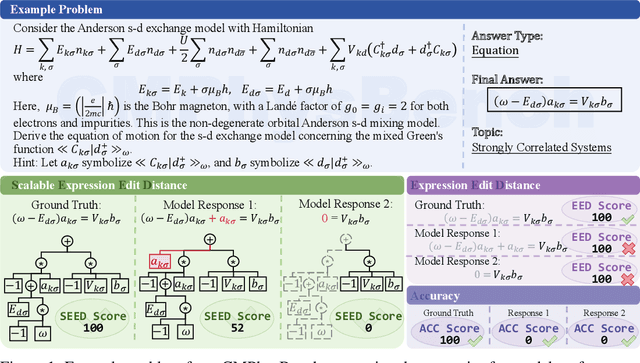
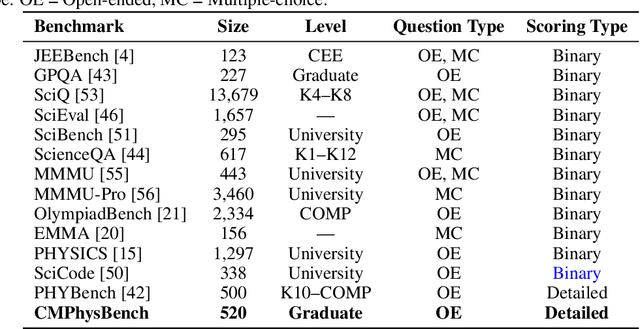


Abstract:We introduce CMPhysBench, designed to assess the proficiency of Large Language Models (LLMs) in Condensed Matter Physics, as a novel Benchmark. CMPhysBench is composed of more than 520 graduate-level meticulously curated questions covering both representative subfields and foundational theoretical frameworks of condensed matter physics, such as magnetism, superconductivity, strongly correlated systems, etc. To ensure a deep understanding of the problem-solving process,we focus exclusively on calculation problems, requiring LLMs to independently generate comprehensive solutions. Meanwhile, leveraging tree-based representations of expressions, we introduce the Scalable Expression Edit Distance (SEED) score, which provides fine-grained (non-binary) partial credit and yields a more accurate assessment of similarity between prediction and ground-truth. Our results show that even the best models, Grok-4, reach only 36 average SEED score and 28% accuracy on CMPhysBench, underscoring a significant capability gap, especially for this practical and frontier domain relative to traditional physics. The code anddataset are publicly available at https://github.com/CMPhysBench/CMPhysBench.
Optimal Brain Connection: Towards Efficient Structural Pruning
Aug 07, 2025Abstract:Structural pruning has been widely studied for its effectiveness in compressing neural networks. However, existing methods often neglect the interconnections among parameters. To address this limitation, this paper proposes a structural pruning framework termed Optimal Brain Connection. First, we introduce the Jacobian Criterion, a first-order metric for evaluating the saliency of structural parameters. Unlike existing first-order methods that assess parameters in isolation, our criterion explicitly captures both intra-component interactions and inter-layer dependencies. Second, we propose the Equivalent Pruning mechanism, which utilizes autoencoders to retain the contributions of all original connection--including pruned ones--during fine-tuning. Experimental results demonstrate that the Jacobian Criterion outperforms several popular metrics in preserving model performance, while the Equivalent Pruning mechanism effectively mitigates performance degradation after fine-tuning. Code: https://github.com/ShaowuChen/Optimal_Brain_Connection
Hot-Swap MarkBoard: An Efficient Black-box Watermarking Approach for Large-scale Model Distribution
Jul 28, 2025

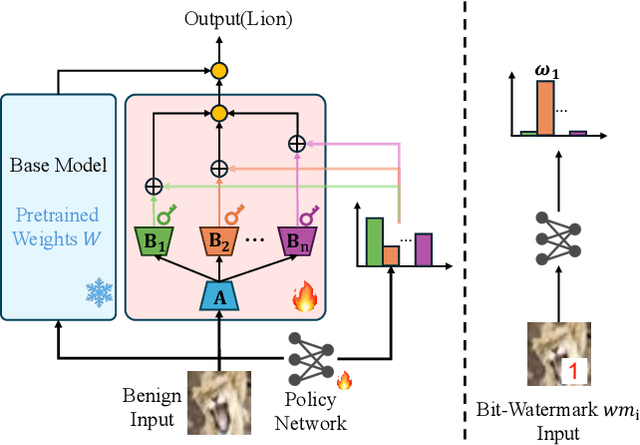

Abstract:Recently, Deep Learning (DL) models have been increasingly deployed on end-user devices as On-Device AI, offering improved efficiency and privacy. However, this deployment trend poses more serious Intellectual Property (IP) risks, as models are distributed on numerous local devices, making them vulnerable to theft and redistribution. Most existing ownership protection solutions (e.g., backdoor-based watermarking) are designed for cloud-based AI-as-a-Service (AIaaS) and are not directly applicable to large-scale distribution scenarios, where each user-specific model instance must carry a unique watermark. These methods typically embed a fixed watermark, and modifying the embedded watermark requires retraining the model. To address these challenges, we propose Hot-Swap MarkBoard, an efficient watermarking method. It encodes user-specific $n$-bit binary signatures by independently embedding multiple watermarks into a multi-branch Low-Rank Adaptation (LoRA) module, enabling efficient watermark customization without retraining through branch swapping. A parameter obfuscation mechanism further entangles the watermark weights with those of the base model, preventing removal without degrading model performance. The method supports black-box verification and is compatible with various model architectures and DL tasks, including classification, image generation, and text generation. Extensive experiments across three types of tasks and six backbone models demonstrate our method's superior efficiency and adaptability compared to existing approaches, achieving 100\% verification accuracy.
Sampling-Based Grasp and Collision Prediction for Assisted Teleoperation
Apr 25, 2025Abstract:Shared autonomy allows for combining the global planning capabilities of a human operator with the strengths of a robot such as repeatability and accurate control. In a real-time teleoperation setting, one possibility for shared autonomy is to let the human operator decide for the rough movement and to let the robot do fine adjustments, e.g., when the view of the operator is occluded. We present a learning-based concept for shared autonomy that aims at supporting the human operator in a real-time teleoperation setting. At every step, our system tracks the target pose set by the human operator as accurately as possible while at the same time satisfying a set of constraints which influence the robot's behavior. An important characteristic is that the constraints can be dynamically activated and deactivated which allows the system to provide task-specific assistance. Since the system must generate robot commands in real-time, solving an optimization problem in every iteration is not feasible. Instead, we sample potential target configurations and use Neural Networks for predicting the constraint costs for each configuration. By evaluating each configuration in parallel, our system is able to select the target configuration which satisfies the constraints and has the minimum distance to the operator's target pose with minimal delay. We evaluate the framework with a pick and place task on a bi-manual setup with two Franka Emika Panda robot arms with Robotiq grippers.
DuckSegmentation: A segmentation model based on the AnYue Hemp Duck Dataset
Mar 27, 2025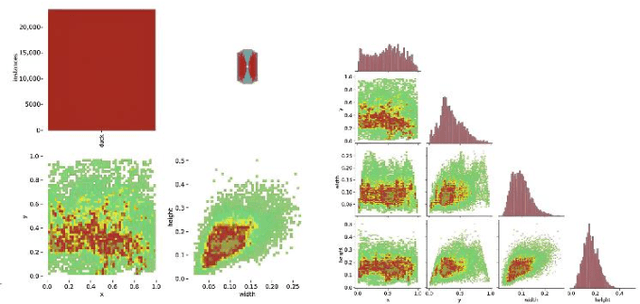

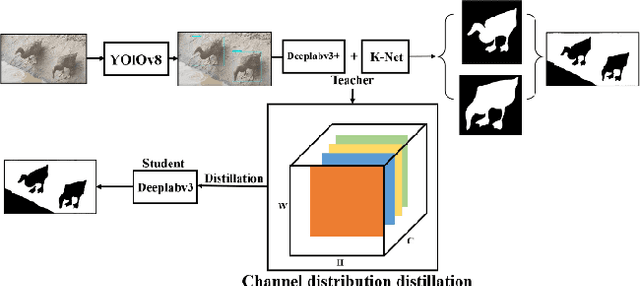

Abstract:The modernization of smart farming is a way to improve agricultural production efficiency, and improve the agricultural production environment. Although many large models have achieved high accuracy in the task of object recognition and segmentation, they cannot really be put into use in the farming industry due to their own poor interpretability and limitations in computational volume. In this paper, we built AnYue Shelduck Dateset, which contains a total of 1951 Shelduck datasets, and performed target detection and segmentation annotation with the help of professional annotators. Based on AnYue ShelduckDateset, this paper describes DuckProcessing, an efficient and powerful module for duck identification based on real shelduckfarms. First of all, using the YOLOv8 module designed to divide the mahjong between them, Precision reached 98.10%, Recall reached 96.53% and F1 score reached 0.95 on the test set. Again using the DuckSegmentation segmentation model, DuckSegmentation reached 96.43% mIoU. Finally, the excellent DuckSegmentation was used as the teacher model, and through knowledge distillation, Deeplabv3 r50 was used as the student model, and the final student model achieved 94.49% mIoU on the test set. The method provides a new way of thinking in practical sisal duck smart farming.
Exploring the Roles of Large Language Models in Reshaping Transportation Systems: A Survey, Framework, and Roadmap
Mar 27, 2025Abstract:Modern transportation systems face pressing challenges due to increasing demand, dynamic environments, and heterogeneous information integration. The rapid evolution of Large Language Models (LLMs) offers transformative potential to address these challenges. Extensive knowledge and high-level capabilities derived from pretraining evolve the default role of LLMs as text generators to become versatile, knowledge-driven task solvers for intelligent transportation systems. This survey first presents LLM4TR, a novel conceptual framework that systematically categorizes the roles of LLMs in transportation into four synergetic dimensions: information processors, knowledge encoders, component generators, and decision facilitators. Through a unified taxonomy, we systematically elucidate how LLMs bridge fragmented data pipelines, enhance predictive analytics, simulate human-like reasoning, and enable closed-loop interactions across sensing, learning, modeling, and managing tasks in transportation systems. For each role, our review spans diverse applications, from traffic prediction and autonomous driving to safety analytics and urban mobility optimization, highlighting how emergent capabilities of LLMs such as in-context learning and step-by-step reasoning can enhance the operation and management of transportation systems. We further curate practical guidance, including available resources and computational guidelines, to support real-world deployment. By identifying challenges in existing LLM-based solutions, this survey charts a roadmap for advancing LLM-driven transportation research, positioning LLMs as central actors in the next generation of cyber-physical-social mobility ecosystems. Online resources can be found in the project page: https://github.com/tongnie/awesome-llm4tr.
Unveiling Pitfalls: Understanding Why AI-driven Code Agents Fail at GitHub Issue Resolution
Mar 16, 2025Abstract:AI-driven software development has rapidly advanced with the emergence of software development agents that leverage large language models (LLMs) to tackle complex, repository-level software engineering tasks. These agents go beyond just generation of final code; they engage in multi-step reasoning, utilize various tools for code modification and debugging, and interact with execution environments to diagnose and iteratively resolve issues. However, most existing evaluations focus primarily on static analyses of final code outputs, yielding limited insights into the agents' dynamic problem-solving processes. To fill this gap, we conduct an in-depth empirical study on 3,977 solving-phase trajectories and 3,931 testing-phase logs from 8 top-ranked agents evaluated on 500 GitHub issues in the SWE-Bench benchmark. Our exploratory analysis shows that Python execution errors during the issue resolution phase correlate with lower resolution rates and increased reasoning overheads. We have identified the most prevalent errors -- such as ModuleNotFoundError and TypeError -- and highlighted particularly challenging errors like OSError and database-related issues (e.g., IntegrityError) that demand significantly more debugging effort. Furthermore, we have discovered 3 bugs in the SWE-Bench platform that affect benchmark fairness and accuracy; these issues have been reported to and confirmed by the maintainers. To promote transparency and foster future research, we publicly share our datasets and analysis scripts.
 Add to Chrome
Add to Chrome Add to Firefox
Add to Firefox Add to Edge
Add to Edge